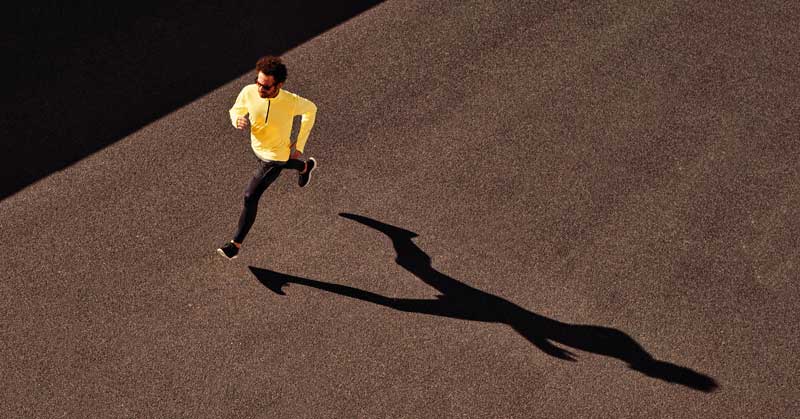
The mini-hurdle run not only allows coaches to work on perfect timing but also lets us work on lateral strength. Both are attributes that every fast, efficient, and injury-free runner displays.
The push runner who has an extended leg in back and low knee drive often shares the same characteristics of a runner with a crossover gait. Dr. Shawn Allen, of The Gait Guys, and I began investigating this concept years ago. We watched film clip after film clip of runners from a side angle, trying to determine how we could not only prevent injuries but also help athletes run faster.
During this time, one of Dr. Allen’s clients, who had chronic hip and knee pain, was featured running in a local advertisement. We looked at the YouTube clip, where the camera angle was from the front, and quickly discovered the runner had a crossover gait. We watched as she took three strides down the line on the side of a country road. Each stride crossed over the line and landed on the wrong side of her body. Sirens wailed, lights flashed, and the world changed.
Top sprinters land their feet directly under their hips. Share on XWe started filming as many runners as possible from the front and breaking down the filmed movements. Dr. Allen had the ability to test muscles to match the runner’s gait, which enabled us to deduce the problem. We searched for other research on the issue and found very little. So we started to play. YouTube was helpful to watch top sprinters run. Each runner landed their foot directly under their hip. The slower the athlete, the more the hip drifted toward the middle. This was consistent with both distance runners and sprinters. Like a thermometer, we could identify the problem. We wanted to become a thermostat so we could change things.
The Problematic Crossover Gait Motor Pattern: Part 1
The Problematic Crossover Gait Motor Pattern: Part 2
Since we understood that crossing over caused problems, we decided to design exercises to improve the pattern and change running form. We played with basic side planks. However, they did not build the strength necessary to hold the hip in place as a runner’s body weight, doubled, crashes down when the leg hits the ground. Hip hikes on a Swiss ball were an improvement because the foot is in contact with the ground. But they still lacked the appropriate force.
Next, I painted a line down my very long driveway and had my athletes run down the line, focusing on where their foot placement occurred. Sure enough, the athletes felt the stress on their hips. To help them space out their stride and force them to focus on raising their knees up, I placed 6-inch mini hurdles at 1.5 and 1.7m intervals and told them to run through. I could see them start to improve.
After this revelation, I watched Frans Bosch’s Running DVD again. He talked about foot placement relative to the hips. To further stress the hip, Bosch suggested runners fully extend their arms over their heads. We tried it, and it worked.
At this point, using my old school American strength coach mentality, I figured if I added weight, the results would be better. I found myself at a junkyard looking for weighted poles. I found 10, 20, 30, and 35-lb iron bars and had my athletes run with the 10-lb bars raised over their heads. And it worked. I observed noticeable differences in my athletes.
I do not add more than 10 pounds to a runner’s program for quite some time. I look for quickness off the ground first. Then I start to spread out the distance to 1.7m and 1.9m. When the athletes look good at 1.9m, I allow them to add weight. My fastest runners can handle heavier weight.
To add even more stress to the lateral sling, I put pieces of track, approximately ¼ to ½-inch, between the hurdles. This creates additional stress when hitting the ground. When we add speed through the hurdles and short distances between the hurdles, we create a challenging environment.
Keep in mind that this is a progression. A coach can wreck an athlete if they jump to the coolest exercise too soon. Patience is the key.




